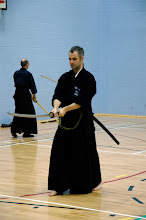At the trusted radio programme “Ask a Squirrely Wrangler”, we received the following question from avid listener, Simon…
--------
“The question is about the commands for reiho.
Mostly in the context of bigger national or international seminars.
(Side note: I've noticed that on dojo-level there is a large variety of ways to do this. So I am assuming this is more of a local dojo-culture rather than a uniform set of rules.)
Could you please explain what the correct order of the commands for the opening and closing reiho is, and if there is a reason behind that order.
Also, when is it appropriate or not to use certain commands?
I am familiar with most common commands, at least on a superficial level, but I feel I am lacking a bit of context for some of their applications.
And there are, of-course, also specific differences for Iaido and Jodo.
I am thinking of commands like these. Although, I'm sure I'm forgetting some.
Shomen ni rei
Sensei ni rei
Otagai ni rei
Sogo ni rei
Shinza ni rei
Ichido rei
kokki ni rei (I guess only relevant for European championships)
Seiretsu
Ki wo tsuke
hairei
Sorry for my long-winded way of posing a short question.
But as I said, please only consider answering if you have the time to spare.”
-------
Essentially at a dojo level it is up to the dojo leadership to decide on the order of commands. This is influenced by lineage and custom as well as time available in any training session to do reigi.
There is a custom to bow from most important to least important in the opening and the reverse order in the closing, an example in Jodo would be:
- Shomen ni Rei
- Sensei ni Rei
- Sogo ni Rei
and then
- Sogo ni Rei
- Sensei ni Rei
- Shomen ni Rei
Which would be easy to remember except that Sogo ni Rei is often used as a general greeting and therefore goes at the end of both opening and closing stages, i.e.,
- Shomen ni Rei
- Sensei ni Rei
- Sogo ni Rei
and then
- Sensei ni Rei
- Shomen ni Rei
- Sogo ni Rei
In our dojo, we don't have a lot of time as we do both iaido and jodo in the same session totalling 4 reiho episodes. To cut out time-consuming sitting and standing, for iaido we do:
- Shomen ni Rei
- Sensei ni Rei
- To ni Rei (we don't do a command for this)
and then
- To ni Rei
- Sensei ni Rei
- Shomen ni Rei
(we then do an informal standing bow to each other with hugs, high-fives and pledges of undying love).
The reason for not doing the command “to ni rei” is that after bowing to the shomen, each individual then enters their own embu or training time and so we don’t usually give a command for this.
In Ishido Sensei’s dojo, usually people come in and out at different times and there isn’t a formal start and end. Individuals come in, put their sword to the right side, bow to Sensei, and then start their shomen ni rei and torei. In principle the reverse is then done when people leave. Should Sensei wish to stop the class at some point, rather than keeping him waiting sometimes practitioners simply sit down in taito, take their sword out and place it to the side, bow to Sensei and then do the rest of the formalities after. At other times the full torei, shomen ni rei and sensei ni rei take place.
I’m not sure about inappropriate commands. I have heard from several high graded teachers both in Japan and the UK that mokuso is for Kendo and is not appropriate for iaido and jodo. I guess it’s really up to the dojo leader but it wouldn’t be appropriate at a seminar.
I will now go through the individual terminology:
Shomen ni rei - this means “bow to the front”. The time to use this is when there isn’t a formal shinzen or kamiza (for further details see “Shinza (or Shinzen) ni rei”)
Sensei ni rei - pretty self explanatory but it’s “sensei ni rei” for one teacher “senseigata ni rei” if there is more than one.
Otagai ni rei - this means “bow to each other” and it interchangeable with “sogo ni rei”
Sogo ni rei - …which has now been formally accepted by the ZNKR Jodo syllabus so one should stop using otagai ni rei in formal proceedings.
Shinza ni rei - or shinzen ni rei….when is a shinzen a shinzen? There is a guide. If it happens to be located on a wall so high up that it can’t be touched simply from the ground then it is a shinzen (it of course should be something like a small altar). If it can be reached from the ground then it is just a shomen.
Ichido rei - like sogo ni rei, this means “all together bow”. It’s not “officially” recognised in the ZNKR manuals, personally I use it as a final command at the end of a day’s events just to add a bit of exciting variety.
kokki ni rei (I guess only relevant for European championships) - correct, this means “bow to the national flag(s)”. If there aren’t any national flags then “shomen ni rei” will do but when there are some then these are what should be bowed to…..complicated innit?
Seiretsu - this is a command which translates as “straight lines”. We most often use it to mean “line up for some joyful bowing”. When doing jodo tandoku dosa or sotai dosa, the expression for people to get into straight lines is usually “seiton” (arrange yourselves).
Ki wo tsuke - means “be careful” but is used to command “Attention!” when lining up.
Hairei - this is simply putting the honorific “hai” before rei. In the dojo this is appropriate for both shomen and the sensei(s), less so for each other as it would be an honorific among equals.
Hopefully that answers that question comprehensively. If you have any questions for “Ask a Squirrel Wrangler” then please send them to the usual address at The Drey, A Tree, In a nice garden, Nutlington.








No comments:
Post a Comment